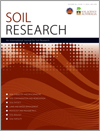SR19153No-tillage furrow opener performance: a review of tool geometry, settings and interactions with soil and crop residue
 , James B. Barr
, James B. Barr  , Mustafa Ucgul
, Mustafa Ucgul  , Troy A. Jensen, Diogenes L. Antille
, Troy A. Jensen, Diogenes L. Antille  and Jack M. A. Desbiolles
and Jack M. A. Desbiolles 
In no-tillage farming, seeder furrow openers provide the soil loosening and opening for seed and fertiliser placement. Optimisation of seeding opener performance includes minimum soil disturbance, low power (fuel) requirement, optimum seedbed and seed depth for germination and crop growth, minimum interference with residue handling and seed–fertiliser separation. Factors to consider in achieving these targets include opener geometry, operating speed and depth, soil and residue conditions, and seed and fertiliser boot design.




